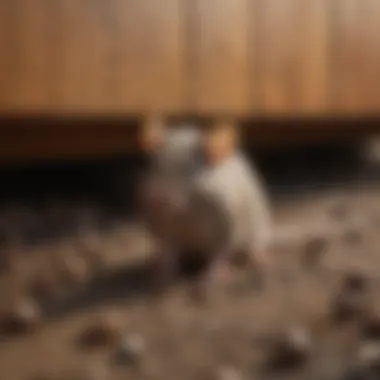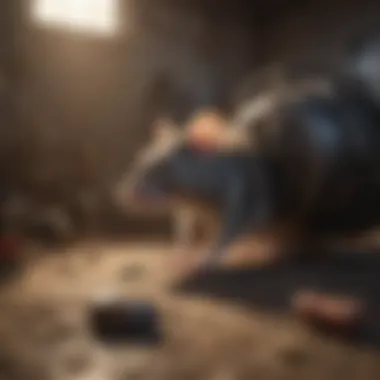Effective Strategies for Dealing with a Rat Infestation Outside Your Home


Preventive Pest Control Strategies
House Exterior Protection
- Tips for sealing cracks: Inspecting your house for any openings is essential to prevent rodents from entering. Seal cracks with weather-resistant materials to deny rats access through tiny openings.
- Clearing debris: Removing debris around your house eliminates potential nesting areas for pests. Keeping the surroundings clean and tidy reduces the chances of attracting unwanted critters.
- Preventing pests from entering: Installing wire mesh in crawl spaces and employing door sweeps can act as barriers to keep rodents out of your home.
Yard Maintenance
- Essential yard care routines: Regular mowing, pruning, and clearing clutter in the yard can reduce hiding spots for rats and other pests.
- Methods for keeping the yard pest-free: Utilizing natural repellents like garlic or peppermint sprays can deter pests from taking up residence in your yard.
Indoor Cleanliness
- Expert cleaning tips and techniques: Regular cleaning and disinfecting surfaces can help in detecting and preventing any signs of infestation at an early stage.
- Maintaining a pest-resistant indoor environment: Proper storage of food in airtight containers and promptly fixing leaks can make your home less attractive to rodents seeking food and shelter.
Garbage Disposal
- Efficient waste disposal methods: Using secure trash bins with tightly sealed lids can discourage rats from rummaging through your garbage.
- Importance of proper garbage disposal: Avoiding leaving food scraps in open bins outside can significantly reduce the likelihood of attracting rodents to your property.
Other Pest Prevention Strategies
- Innovative ways to safeguard your home: Employing ultrasonic devices or motion-activated sprinklers can provide additional layers of protection against unwanted pests.
Recognizing Signs of a Rat Infestation
Recognizing signs of a rat infestation is crucial in effectively addressing the issue and safeguarding your home. By being vigilant and observant, you can mitigate potential damage and health risks associated with these pests. This section delves into key indicators that signal a rat presence and serves as the foundational step in combating the problem.
Gnawed Items and Droppings
Identifying Damage on Property
Identifying damage on your property is a telling sign of a rat invasion. Gnawed items such as wires, wood, or food packaging indicate the presence of rats seeking food and nesting materials. This destruction can lead to structural issues and electrical hazards if not promptly addressed. Recognizing this type of damage allows you to take proactive measures to prevent further harm and eliminate these unwanted intruders.
Spotting Rat Droppings
Spotting rat droppings is a clear indication of a rat infestation. These droppings are typically dark and pellet-shaped, commonly found near food sources or along pathways frequented by rats. Identifying and promptly removing these droppings is essential in limiting the spread of diseases and preventing the proliferation of rats in your surroundings. Regularly monitoring and disposing of rat droppings aids in gauging the extent of the infestation and guiding your pest control efforts.
Unusual Pet Behavior
Observing Changes in Pet's Behavior
Pets can act as early indicators of a rat problem through changes in their behavior. Unusual barking, scratching, or heightened alertness may signal the presence of rodents. By observing your pet's reactions, you can proactively investigate potential rat hotspots and take necessary precautions to safeguard both your furry companions and your home. Understanding and interpreting your pet’s behavior enables you to address rat infestations swiftly and efficiently.


Scratching Noises
Listening for Sounds of Scratching
Scratching noises emanating from walls or ceilings are often an auditory cue of rats inhabiting your property. These sounds indicate rodent activity, such as nesting or foraging for food. By actively listening for scratching noises, you can pinpoint rat locations and strategize pest control measures accordingly. Recognizing and responding to these sounds promptly is essential in effectively eradicating rats and securing your home from further infestations.
Assessing the Scope of the Infestation
Outdoor Inspection
Checking Exterior of Property
In the outdoor inspection phase, checking the exterior of your property plays a significant role in understanding how rats are accessing your premises. This involves a thorough examination of your house's foundation, entry points, gaps, or cracks that may serve as pathways for rodents. By identifying these vulnerable areas, you can implement necessary measures to seal off potential entry points, preventing further infestations. Checking the exterior is a popular choice as it offers a proactive approach to rat control, allowing homeowners to fortify their property against unwanted intruders. The unique feature of this aspect lies in its ability to target rat entry points directly, reducing the risk of recurring infestations. While advantageous in promoting long-term pest prevention, a potential disadvantage may be the time and effort required to conduct a detailed inspection. However, the benefits of securing your property's exterior far outweigh the drawbacks, making it a crucial step in addressing rat issues.
Inspecting Garbage Areas
Inspecting garbage areas is another essential component of the outdoor inspection process. Rats are attracted to food sources, and garbage areas can serve as feeding grounds for these pests. By scrutinizing these zones, you can identify any signs of rat activity, such as gnaw marks, droppings, or burrows. This vigilance helps in pinpointing areas that require immediate attention to deter rodents from congregating near your property. Inspecting garbage areas is beneficial as it aids in cutting off a vital food supply for rats, discouraging them from loitering around your house. The unique feature of this task lies in its direct impact on rat behavior, disrupting their access to nourishment and forcing them to seek sustenance elsewhere. While advantageous in reducing rat attraction to your property, a potential disadvantage could be the odorous and unhygienic nature of garbage inspections. However, the benefits of proactively managing waste areas to control rat infestations outweigh any discomfort.
Indoor Assessment
Searching for Nesting Areas
When conducting an indoor assessment, searching for nesting areas is indispensable in uncovering rat shelters within your property. Rats often seek secluded, warm spaces to build their nests and reproduce, leading to hidden infestation hubs. By identifying these nesting grounds, you can target the heart of the issue and eliminate rat populations from their core habitats. Searching for nesting areas is a beneficial choice as it allows for the eradication of established colonies, preventing further proliferation. The unique feature of this task lies in its capacity to disrupt rat reproduction cycles, limiting future infestations. While advantageous in mitigating long-term rat problems, a potential disadvantage may involve the challenges of accessing confined or cluttered spaces during the search process. Nonetheless, the benefits of rooting out nesting areas far outweigh the obstacles, making it a critical step in indoor rat control.
Examining Attic and Basement
Examining the attic and basement areas is a vital aspect of indoor assessment to target potential rat hiding spots. These secluded areas often provide rats with ample shelter and protection, making them prime locations for infestations. By thoroughly inspecting these spaces, you can detect any signs of rat presence, such as nests, droppings, or chewed items. Examining the attic and basement is a beneficial choice as it allows for the eradication of rats from core indoor zones where they may cause the most damage. The unique feature of this task lies in its focus on high-risk areas within the house, minimizing the chances of overlooked infestations. While advantageous in ensuring comprehensive indoor pest control, a potential disadvantage may be the time-intensive nature of examining these less frequented sections of the house. Nevertheless, the benefits of securing attic and basement areas outweigh any inconveniences, making it a crucial step in combating indoor rat problems.
Implementing Preventive Measures
Implementing preventive measures involves various specific elements that target vulnerabilities in and around your house. One key benefit of implementing these measures is the long-term protection they offer against rat invasions. By addressing food sources and entry points early on, individuals can prevent costly damages and health risks associated with rat infestations.
When considering implementing preventive measures, it is essential to take into account factors such as the layout of your property, common entry points for rats, and existing attractants that might lure them in. By being proactive in securing your home against rat infestations, you not only protect your property but also safeguard the well-being of your family.
Securing Food Sources
Proper Storage of Food
Proper storage of food plays a pivotal role in preventing rat infestations around your house. Storing food correctly helps eliminate potential food sources that rats are attracted to, reducing the incentive for them to enter your property. The key characteristic of proper storage of food lies in sealing all food items in airtight containers to prevent access for rodents.
A beneficial aspect of proper storage of food is its effectiveness in minimizing the risks of contamination and spoilage that may occur when exposed to rodents. By storing food securely, individuals can maintain a hygienic environment and prevent health hazards associated with rat-borne diseases. The unique feature of proper food storage is its ability to preserve the quality and safety of food items, ensuring that they remain consumable and free from pest infestations.
Sealing Trash Bins


Sealing trash bins is another essential aspect of securing food sources to deter rats from foraging outside your house. Properly sealing trash bins helps to contain odors that attract rats and other pests, reducing the likelihood of them lingering near your property. The key characteristic of sealed trash bins is their ability to prevent easy access for rodents and pests, minimizing the chances of attracting unwanted visitors.
A significant advantage of sealing trash bins is the reduction of litter and waste that can serve as potential food sources for rats. By securely sealing trash bins, individuals can maintain a clean outdoor environment and discourage pests from infiltrating their surroundings. However, a potential disadvantage of this measure is the inconvenience of regularly checking and emptying the bins to ensure they remain tightly sealed, requiring consistent upkeep.
Eliminating Entry Points
When aiming to address a rat problem outside your house, eliminating entry points is a critical step in fortifying your property against rodent intrusions. By sealing cracks and holes, individuals can restrict rats' access to the interior of the house, minimizing the chances of infestations. The key characteristic of sealing cracks and holes is its ability to close off potential entryways that rats exploit to gain entry into buildings.
One of the main benefits of sealing cracks and holes is the enhancement of structural integrity, as these openings can compromise the building's foundation and insulation when left unchecked. By sealing off these points of entry, homeowners can also improve energy efficiency and weatherproofing, contributing to cost savings and overall comfort within the house.
On the other hand, installing door sweeps is a proactive measure to prevent rats from entering through gaps at the bottom of doors. Door sweeps act as a physical barrier, blocking access for rodents and other pests seeking entry. The key characteristic of door sweeps is their ease of installation and effectiveness in sealing off potential entry points without impeding the functionality of the door.
A notable advantage of installing door sweeps is the added protection they provide against drafts and dust infiltration, enhancing indoor air quality and insulation. However, one disadvantage of door sweeps is the potential accumulation of debris and pests in the brush material, requiring regular maintenance to ensure proper functioning and hygiene.
Extermination Strategies
When dealing with a rat infestation outside your house, it is crucial to have a robust plan for extermination. This section of the article focuses on the critical aspect of eliminating rats effectively to ensure a pest-free environment. Extermination strategies play a vital role in eradicating these rodents and preventing further infestations.
Extermination strategies encompass various methods that target and eliminate rats from the surrounding areas. Utilizing these strategies not only removes existing rats but also helps in deterring future intrusions. By understanding and implementing appropriate extermination techniques, homeowners can regain control of their outdoor spaces and protect their property from damage.
Among the essential elements of extermination strategies are the efficiency and effectiveness of the chosen methods. It is imperative to select strategies that are humane, safe for the environment, and tailored to address the specific challenges posed by rat infestations. Additionally, considering the long-term benefits of successful extermination can prevent recurring infestations, ensuring a lasting solution to the problem.
Implementing comprehensive extermination strategies is essential for successfully managing a rat problem outside your house. By combining various approaches and techniques, homeowners can significantly reduce the rat population in their immediate vicinity, promoting a healthier and safer living environment.
Natural Repellents
Peppermint Oil
Peppermint oil is a popular natural repellent that has been shown to be effective in deterring rats from infesting outdoor areas. Its strong scent acts as a deterrent, making it less appealing for rodents to inhabit specific spaces around the house. The key characteristic of peppermint oil lies in its non-toxic nature, making it a safe alternative to traditional chemical repellents.
One of the main advantages of using peppermint oil in combating rat infestations is its eco-friendly properties. Unlike harsh chemicals, peppermint oil is environmentally friendly and poses no harm to pets or humans. Its unique feature of masking the scent trails that rats follow helps disrupt their navigation, leading them to avoid areas treated with peppermint oil.
However, a potential disadvantage of peppermint oil as a natural rat repellent is its limited effectiveness in severe infestation cases. While beneficial for deterring rats in minor infestation scenarios, peppermint oil may not provide sufficient protection in cases where the rat population is high.
Mothballs
Mothballs are another commonly used natural repellent for rats that can help in keeping rodents at bay. Their strong odor repels rats and discourages them from nesting in specific areas outside the house. The key characteristic of mothballs lies in their lingering scent, which creates a barrier that rats find unpleasant.
One of the benefits of using mothballs is their longevity in providing protection against rat infestations. Once placed in strategic locations, mothballs can continue to deter rats for an extended period, offering a cost-effective solution for outdoor pest control. Their unique feature of emitting a strong odor that masks attractive scents for rats makes them a practical choice for preventing infestations.
Despite their effectiveness, mothballs pose potential disadvantages due to their toxicity to pets and children. Care must be taken when using mothballs in outdoor spaces to prevent accidental ingestion or exposure to harmful chemicals.
Traps and Baits


Snap Traps
Snap traps are one of the most commonly used methods for trapping and exterminating rats. Their specific aspect lies in their mechanical design, which snaps shut upon triggering by a rat, effectively killing the rodent. The key characteristic of snap traps is their efficiency in capturing rats quickly and humanely.
The advantages of snap traps include their affordability and ease of use, making them accessible to homeowners looking to address a rat problem outside their houses. Their unique feature of being reusable allows for multiple captures, making them a practical and sustainable option for pest control.
However, a potential disadvantage of snap traps is the need for careful placement to ensure safety for pets and non-target wildlife. Moreover, snap traps require regular monitoring and resetting to maintain their effectiveness in eliminating rats.
Electronic Traps
Electronic traps offer a modern and efficient solution for rat extermination, utilizing electronic sensors to detect and eliminate rodents. Their key characteristic lies in their automatic trigger mechanism, which delivers a deadly shock to rats upon entry, ensuring a swift and humane elimination process.
The benefits of electronic traps include their precision in targeting rats without the use of harmful chemicals or poisons. Their unique feature of being able to capture multiple rats without resetting makes them a convenient option for homeowners dealing with moderate to severe infestations.
Despite their advantages, electronic traps may pose disadvantages in terms of initial investment costs and maintenance requirements. Homeowners should consider their operational needs and budget constraints before opting for electronic traps as part of their rat extermination strategy.
Professional Pest Control
Hiring Exterminators
Hiring professional exterminators is a critical aspect of rat extermination, especially in cases of severe infestations that require expert intervention. The key characteristic of hiring exterminators lies in their specialized knowledge and experience in dealing with various pests, including rats, ensuring thorough and effective eradication.
One of the main advantages of hiring exterminators is the comprehensive pest management they provide, including accurate assessment, treatment, and prevention strategies tailored to the specific needs of each property. Their unique feature of using advanced equipment and techniques enhances the success rate of rat extermination, offering homeowners a reliable solution to their pest problems.
However, potential disadvantages of hiring exterminators may include higher costs compared to DIY methods and the need for ongoing maintenance to prevent future infestations. Homeowners should weigh the benefits of professional pest control against the associated expenses to make an informed decision based on their budget and infestation severity.
Monitoring and Maintenance
Regular Inspections
- Checking Vulnerable Areas
Checking Vulnerable Areas
Delving into the specifics of checking vulnerable areas is a critical component of overall monitoring and maintenance strategies. This meticulous task involves scrutinizing potential entry points, such as gaps in walls, drainage pipes, or vents, that rats could exploit to gain access to your home. Through diligent examination and reinforcement of these vulnerable areas, homeowners can significantly reduce the risk of rat intrusion. The key characteristic of focusing on vulnerable areas lies in its proactive nature, addressing potential weaknesses before they escalate into full-blown infestation problems. The unique feature of this approach is its preventive stance, which serves as a barrier against possible rat incursions. Understanding the importance of checking vulnerable areas empowers homeowners to fortify their defenses and maintain a rat-free environment in their households.
Sustainability Practices
- Maintaining Cleanliness
Maintaining Cleanliness
When it comes to implementing maintaining cleanliness as part of monitoring and maintenance routines, the benefits are manifold. Keeping the surrounding areas clean not only deters rats attracted to food sources and shelter but also eliminates potential hiding spots for them. This proactive measure not only contributes to a healthier living environment but also disrupts the favorable conditions for rats to inhabit. The unique feature of maintaining cleanliness is its simplicity yet effectiveness in rat prevention efforts. While there may be extra effort involved in regular cleaning, the advantages far outweigh the disadvantages. By making cleanliness a priority, homeowners can actively reduce the risk of rat infestations and enjoy a pest-free home.
- Garden Maintenance
Garden Maintenance
Incorporating garden maintenance into monitoring and maintenance practices adds another layer of protection against rat infestations. By meticulously tending to the garden, removing debris, trimming overgrown vegetation, and securing outdoor structures, homeowners can minimize hiding places and food sources that attract rats. The key characteristic of garden maintenance is its comprehensive approach in addressing outdoor areas often overlooked in pest prevention strategies. This meticulous care not only enhances the aesthetics of the garden but also disrupts the habitat that rats find appealing. The unique feature of garden maintenance lies in its dual benefits of beautifying outdoor spaces while deterring potential rat problems. Despite the time investment required, the advantages of maintaining a well-kept garden in deterring rats make it a wise choice for homeowners in rat-prone areas.



